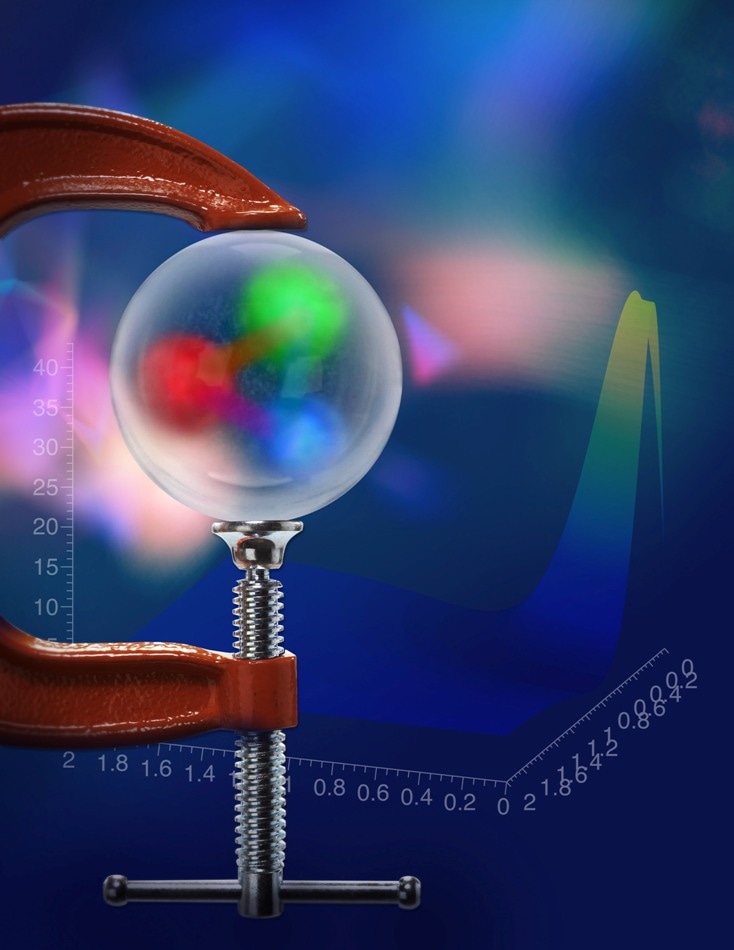May 21 2018
A pressure cooker environment exists within every proton in every atom in the universe and this environment exceeds the atom-crushing core of a neutron star. This is demonstrated by the initial measurement of a mechanical property of subatomic particles, the distribution of pressure within the proton, which was performed by nuclear physicists at Thomas Jefferson National Accelerator Facility of the Department of Energy.
 The first measurement of a subatomic particle’s mechanical property reveals the distribution of pressure inside the proton.(Image credit: Jefferson Lab)
The first measurement of a subatomic particle’s mechanical property reveals the distribution of pressure inside the proton.(Image credit: Jefferson Lab)
The researchers discovered that quarks - the building blocks of proton - are exposed to a pressure of 100 decillion Pascal (1035) close to the heart of a proton, which measures approximately 10 times greater than the pressure in the center of a neutron star. The result of the study has been reported in the journal, Nature.
“We found an extremely high outward-directed pressure from the center of the proton and a much lower and more extended inward-directed pressure near the proton’s periphery,” explains Volker Burkert, Jefferson Lab Hall B Leader, and the paper’s co-author.
According to Burkert, the pressure distribution within the proton is controlled by the strong force—the force that makes a proton by binding three quarks together.
Our results also shed light on the distribution of the strong force inside the proton. We are providing a way of visualizing the magnitude and distribution of the strong force inside the proton. This opens up an entirely new direction in nuclear and particle physics that can be explored in the future.
Volker Burkert
This measurement was once believed to be impossible to achieve and is the outcome of a clever coupling of two hypothetical frameworks with current data.
First, there are the generalized parton distributions (GPDs), which enable scientists to create a 3D image of the structure of the proton as probed by the electromagnetic force. The second is the proton’s gravitational form factors, which elucidate what the proton’s mechanical structure would be if scientists could probe the proton through the gravitational force.
Heinz Pagels, the theorist who came up with the idea of gravitational form factors in 1966, notably observed in the paper describing them that there was “very little hope of learning anything about the detailed mechanical structure of a particle, because of the extreme weakness of the gravitational interaction.”
However, latest theoretical work has linked GPDs to the gravitational form factors, enabling the results from protons’ electromagnetic probes to replace for gravitational probes.
“This is the beauty of it. You have this map that you think you will never get,” stated Latifa Elouadrhiri, a co-author on the paper and a Jefferson Lab staff scientist. “But here we are, filling it in with this electromagnetic probe.”
This electromagnetic probe contains beams of electrons created by a DOE Office of Science User Facility—the Continuous Electron Beam Accelerator Facility. When these electrons are guided into the nuclei of atoms, they electromagnetically interact with the quarks within the protons through a process known as deeply virtual Compton scattering (DVCS).
In the DVCS method, an electron first enters a proton, then exchanges a virtual photon with a quark, and ultimately transfers the energy to the proton and quark. Soon afterward, the proton emits another photon and releases this energy and then continues on intact. This process is similar to the calculations made by Pagels on how the proton can be gravitationally probed through a hypothetical beam of gravitons.
Researchers at the Jefferson Lab obtained their result by exploiting a similarity between the famous hypothetical gravitational and electromagnetic studies.
There’s a photon coming in and a photon coming out. And the pair of photons both are spin-1. That gives us the same information as exchanging one graviton particle with spin-2. So now, one can basically do the same thing that we have done in electromagnetic processes - but relative to the gravitational form factors, which represent the mechanical structure of the proton.
Francois-Xavier Girod, Co-Author & Jefferson Lab Staff Scientist
According to the research team, the technique can next be applied to even more accurate data that will soon be available to cut down the uncertainties faced in the present analysis and start working toward exposing other mechanical properties of the ever-present proton, for example, the mechanical radius of protons and the internal shear forces.